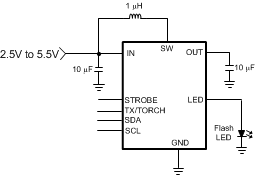SNVS891H September 2012 – September 2015 LM3642
PRODUCTION DATA.
- 1 Features
- 2 Applications
- 3 Description
- 4 Revision History
- 5 Pin Configuration and Functions
- 6 Specifications
- 7 Detailed Description
- 8 Application and Implementation
- 9 Power Supply Recommendations
- 10Layout
- 11Device and Documentation Support
- 12Mechanical, Packaging, and Orderable Information
Package Options
Mechanical Data (Package|Pins)
- YZR|9
Thermal pad, mechanical data (Package|Pins)
Orderable Information
1 Features
- 1.5-A High-Side Current Source for Single LED
- > 85% Efficiency in Torch Mode (at 100 mA) and Flash Mode (at 1 A to 1.5 A)
- Accurate Programmable Flash LED Current from 93 mA to 1.5 A
- Accurate Programmable Torch LED Currents:
- 48.4 mA to 375 mA
- 24 mA to 187 mA (LT option)
- Small Solution Size: < 20 mm2
- Soft-Start Operation for Battery Protection
- Hardware Strobe Enable
- Synchronization Input for RF Power Amplifier Pulse Events
- VIN Flash Monitor Optimization
- 400-kHz I2C-Compatible Interface
- 0.5-mm Pitch, 9-Bump DSBGA
2 Applications
Camera Phone LED Flash
3 Description
The LM3642 is a 4-MHz fixed-frequency synchronous boost converter plus 1.5-A constant current driver for a high-current white LED. The high-side current source allows for grounded cathode LED operation providing Flash current up to 1.5 A. An adaptive regulation method ensures the current source remains in regulation and maximizes efficiency.
The LM3642 is controlled via an I2C-compatible interface. Features include a hardware flash enable (STROBE) allowing a logic input to trigger the flash pulse as well as a TX input which forces the flash pulse into a low-current Torch Mode, allowing for synchronization to RF power amplifier events or other high-current conditions.
The 4-MHz switching frequency, overvoltage protection and adjustable current limit settings allow the use of tiny, low-profile inductors and (10-µF) ceramic capacitors. The device is available in a small 9-bump DSBGA package and operates over the −40°C to 85°C temperature range.
Device Information(1)
| PART NUMBER | PACKAGE | BODY SIZE (MAX) |
|---|---|---|
| LM3642 | DSBGA (9) | 1.69 mm × 1.64 mm |
- For all available packages, see the orderable addendum at the end of the data sheet.
Simplified Schematic
